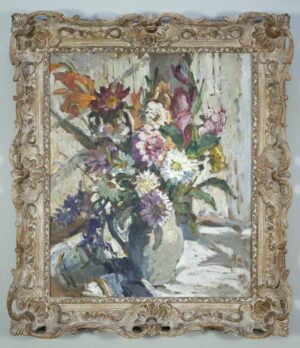Sharp, Dorothea (1874-1955)
Dorothea Sharp took up painting in 1895, at the age of 21 under the tutelage of the Victorian artist, Charles Edward Johnson at his school in Richmond, Surrey. She continued her training at the Regent Street Polytechnic where she was profoundly influenced by two of its regular visiting tutors, Sir David Murray and one of the greatest exponents of British Impressionism, Sir George Clausen. Clausen had a considerable impact on Sharp’s style, encouraging her distinctive use of wide brush-strokes in painting en plein air. Sharp furthered her interests in Impressionism when, after leaving the Polytechnic, she travelled to Paris and studied the work of Claude Monet and Pierre-Auguste Renoir which was then entering the French national collection.
Sharp did not marry but formed great friendships and professional partnerships with other female artists. Settling near Primrose Hill, she formed a close friendship with the visiting Canadian Impressionist Helen Galloway McNicoll. As Natalie Luckyj noted in her biography of the Canadian painter:
“….throughout Britain, Europe and North America, when women like McNicoll and Sharp set out to engage more directly with the institutions of the art world, they were challenging long-held conventions… Dorothea Sharp's company provided McNicoll with camaraderie, security, and saved her from what would have been difficult negotiations with models” (Helen McNicoll had difficulty hearing which made securing models a complex task).
Sharp exhibited regularly throughout her career at many institutions, including the Royal Academy, the Royal Society of British Artists, the Royal Institute of Oil Painters and the Society of Women Artists for which she acted as president for four years. She held her first one–woman show at the Connell Gallery, Glasgow in 1933, which was hugely popular and well attended. Although best known for her works in oil paint, Sharp also designed posters and covers for magazines and wrote a series of articles on oil painting published in The Artist, the editor of which described her as: “one of England's greatest living woman painters … No other woman artist gives us such joyful paintings as she. Full of sunshine and luscious colour, her work is always lively harmonious and tremendously exhilarating … the chief attractions of Miss Sharp's delightful pictures are her happy choice of subjects, and her beautiful colour schemes. Rollicking children bathed in strong sunlight, playing in delightful surroundings, her subjects appeal because they are based on the joy of life. And she presents them equally happily, with a powerful technique which enables her to make the most of her wonderful sense of colour.” (Harold Sawkins, The Artist, April 1935)
Showing the single result
